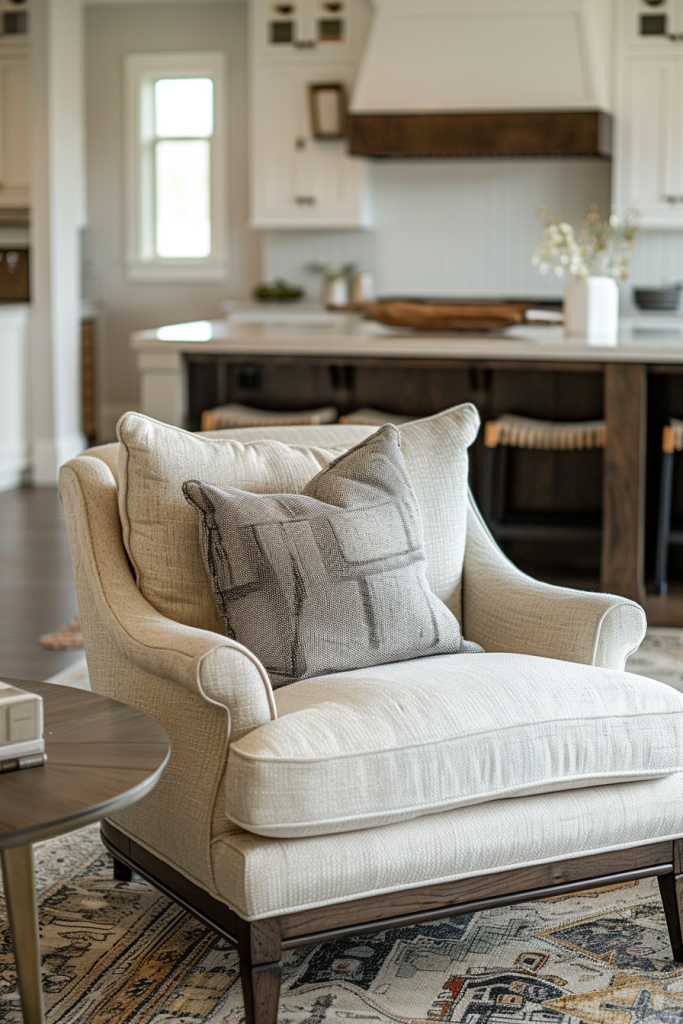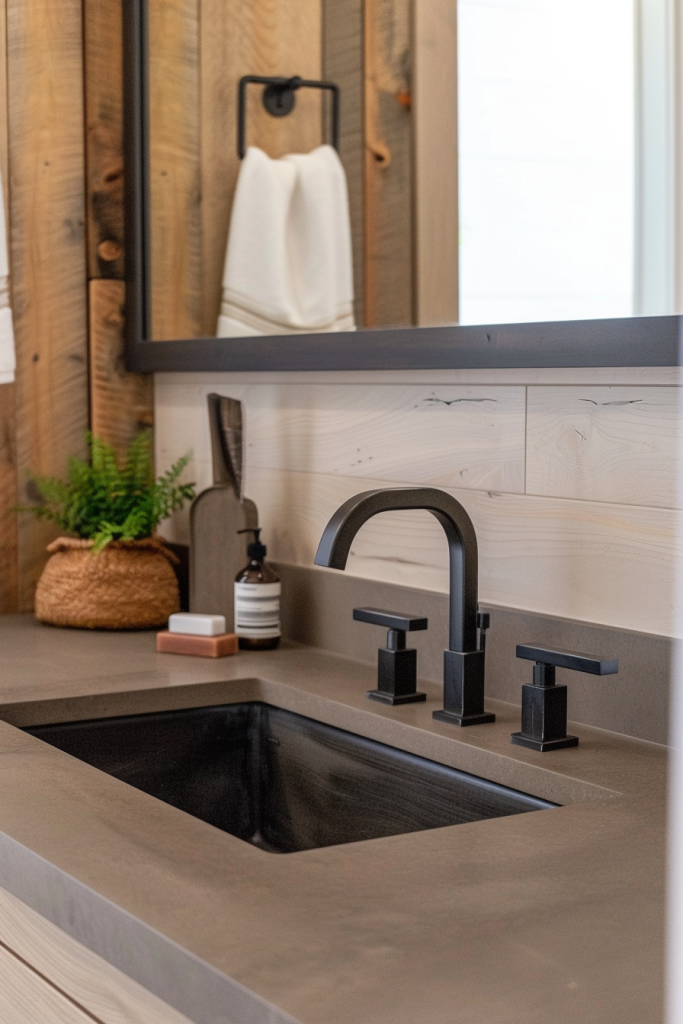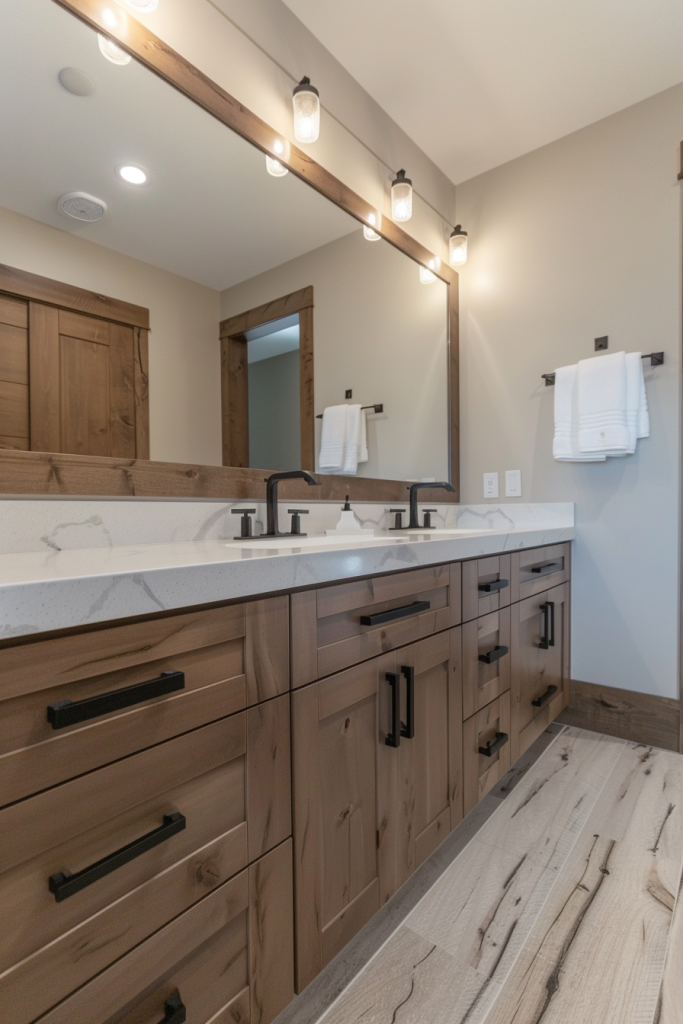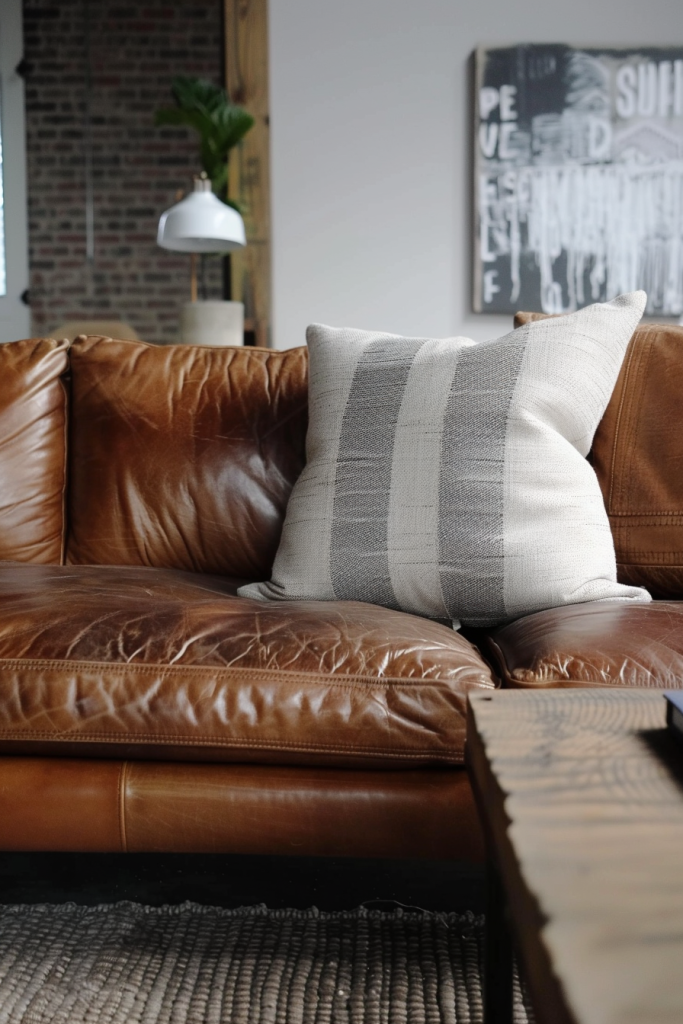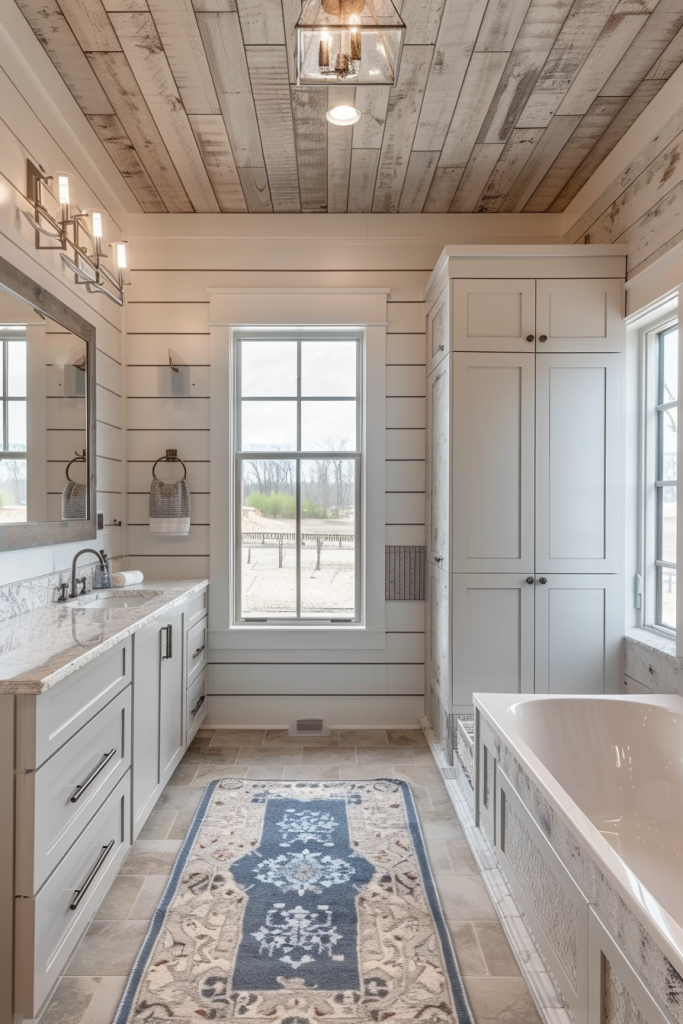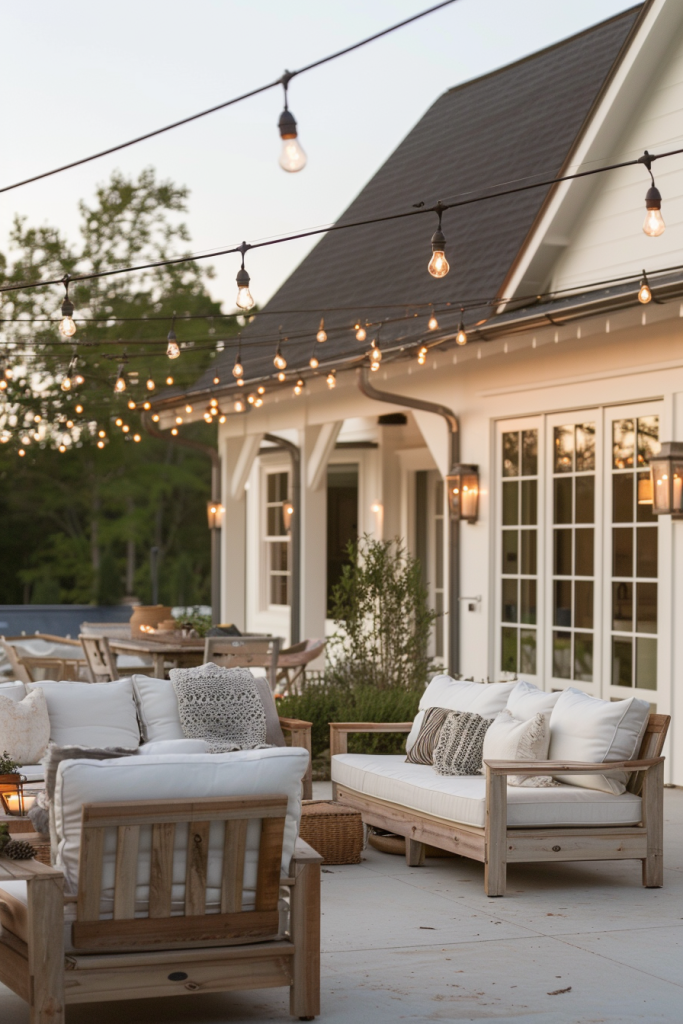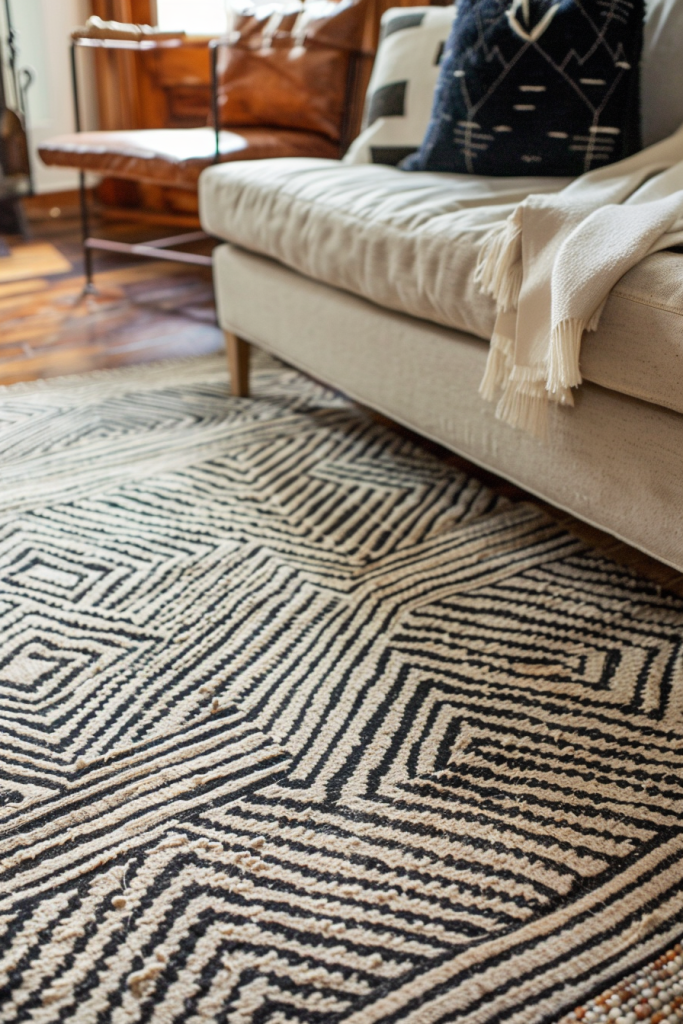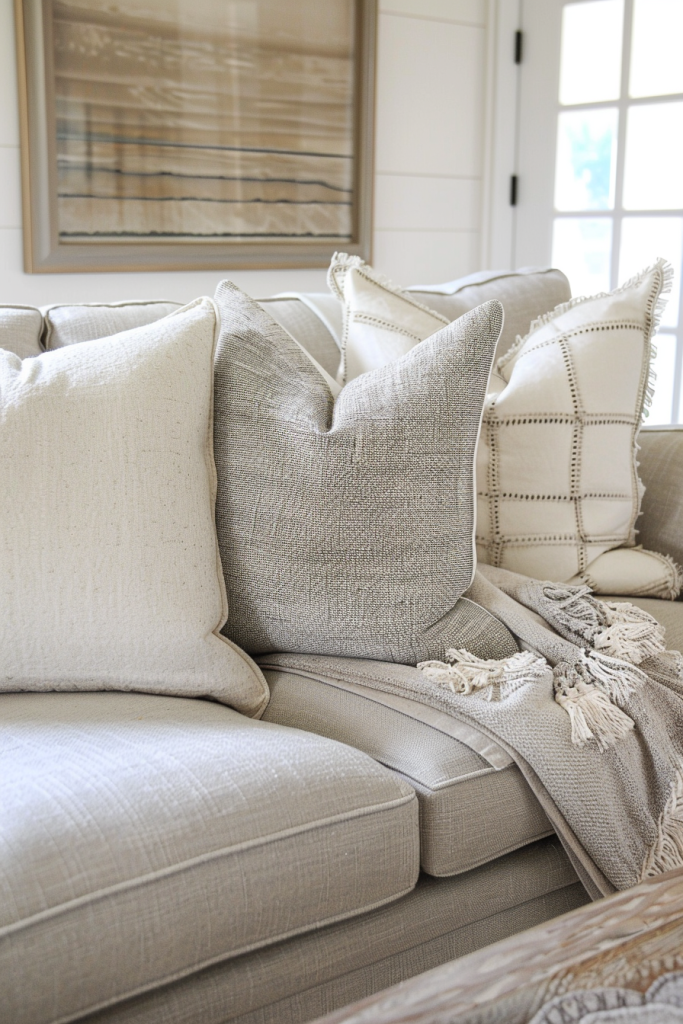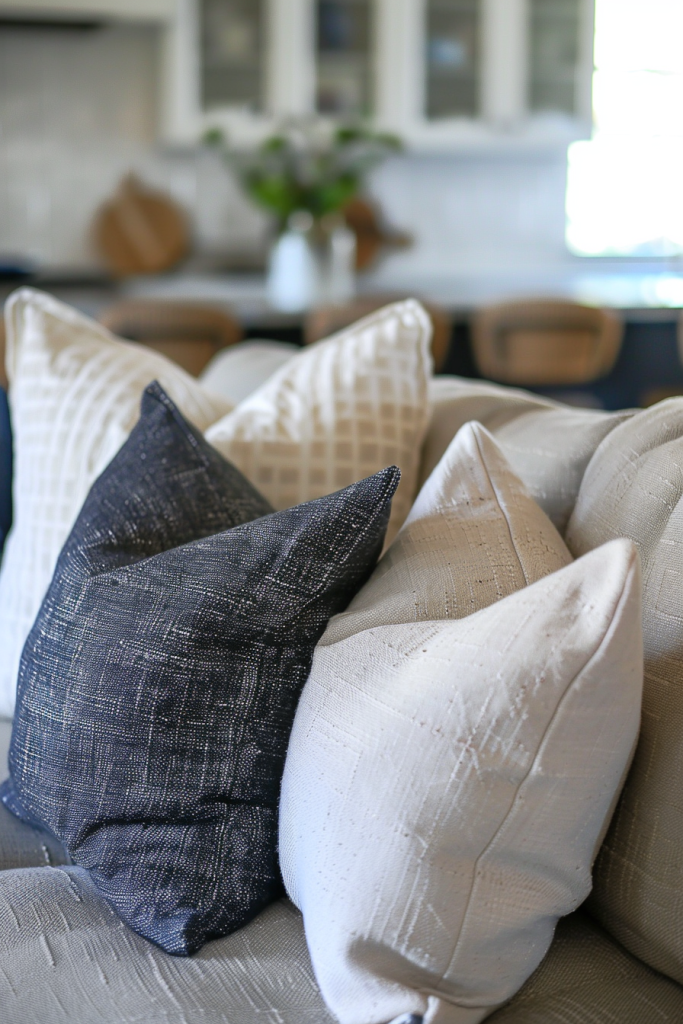- Historical and Cultural Significance
- Key Elements of Modern Farmhouse
- Color Theory Application
- Space Planning and Layout
- Lighting Strategies
- Technology Integrations
- Common Misconceptions
- How to Implement Modern Farmhouse in Different Spaces
- Maintenance Schedule
- Challenges and Solutions
- Impact on Mood and Atmosphere
- Comparison with Other Decor Styles
- Gallery
Modern Farmhouse decor marries the rustic charm of traditional agrarian structures with the clean lines and conveniences of contemporary design. This style emphasizes a comfortable and welcoming atmosphere, bringing together the best of both worlds to create spaces that are both functional and stylish. The enduring popularity of Modern Farmhouse decor lies in its ability to offer a cozy, “lived-in” aesthetic without sacrificing modern practicality, making it suitable for a wide range of homes.
Historical and Cultural Significance
The Modern Farmhouse style is deeply rooted in a blend of American and European rural traditions, originating from practical designs tailored to the agricultural lifestyle. Historically, farmhouses were built by settlers using local materials, reflecting regional architectural styles while focusing on functionality and simplicity. These homes were designed to be sturdy, accommodating, and straightforward, facilitating daily chores and supporting the rural way of life.
American Influence
In America, the farmhouse style evolved from early Colonial designs, which were characterized by their straightforward construction and lack of decorative elements. As America moved into the 19th and early 20th centuries, these homes adapted to include more spacious porches and larger windows, which were designed to improve air circulation and bring in more natural light, enhancing the comfort of indoor spaces.
European Roots
European farmhouses, particularly those in the countryside of France and the United Kingdom, also influenced what would become the Modern Farmhouse aesthetic. These structures often featured stone or timber-frame construction and were built to last through generations. The design was utilitarian but also incorporated artisanal touches that reflected the craftsmanship of the time, such as hand-carved woodwork and forged iron hardware.
Cultural Evolution
Throughout the 20th century, as urbanization increased and lifestyles changed, the farmhouse style began to symbolize a nostalgic ideal of simplicity and connection to nature, distinct from the growing complexity of urban life. This cultural shift influenced the Modern Farmhouse style, infusing contemporary design elements with traditional farmhouse features. The result is a decor style that evokes a sense of warmth and history while providing the comfort and efficiency demanded by modern living.
Contemporary Relevance
Today, the Modern Farmhouse style resonates with many because it represents a return to roots and simplicity, offering a counterbalance to the fast-paced and often impersonal nature of modern urban life. It appeals to those seeking a home that feels both timeless and grounded, yet is practical enough to accommodate contemporary lifestyles. The style’s popularity in recent years can also be seen as part of a broader trend towards sustainability and mindfulness, as it often incorporates eco-friendly materials and practices, reflecting a growing awareness of and desire for sustainability in interior design.
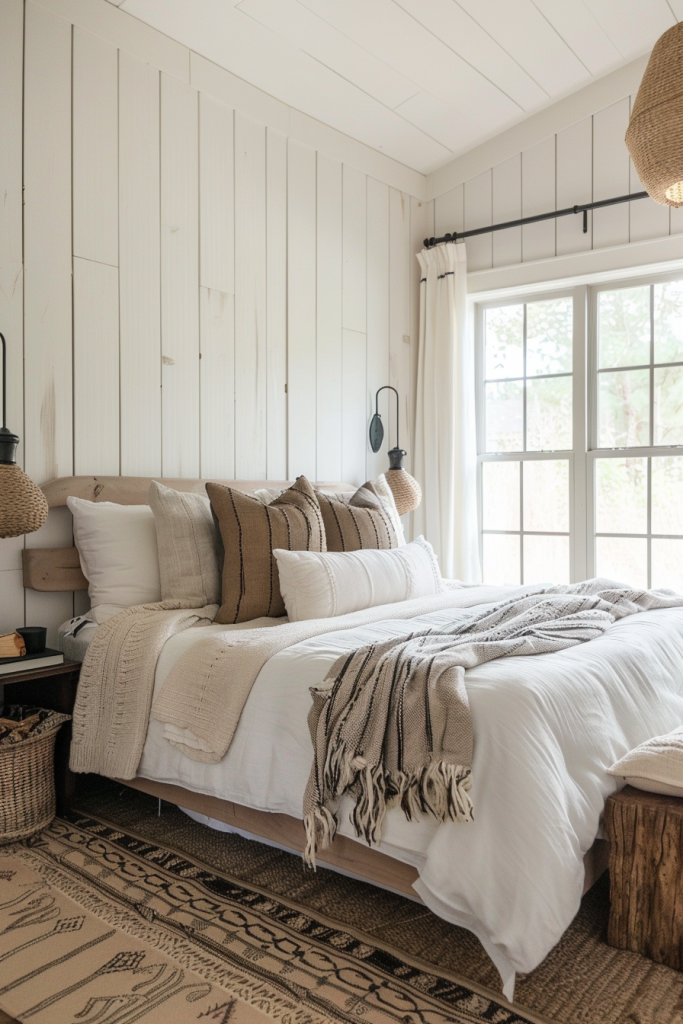
Key Elements of Modern Farmhouse
The Modern Farmhouse style is characterized by several key elements that define its unique aesthetic. These elements blend traditional charm with modern functionality, creating a welcoming and timeless atmosphere. Here’s a detailed look at each of these elements:
Color Schemes
The color palette of Modern Farmhouse decor is predominantly neutral, creating a calm and inviting backdrop that makes spaces feel larger and brighter. Whites and soft grays are staples, often accented by charcoal, navy, or natural wood tones to add depth and warmth. This simplicity in color allows for textures and architectural details to stand out, making the space feel cozy yet uncluttered.
Materials
Natural materials are at the heart of the Modern Farmhouse aesthetic. Reclaimed wood is commonly used for flooring, beams, and furniture, bringing a sense of history and rugged beauty to interiors. Exposed brick and stone add texture and rustic flair, while metals such as wrought iron or brushed nickel are used in fixtures and hardware to introduce a contemporary edge. Fabrics tend to be soft and comfortable, with linen and cotton being popular choices for upholstery and window treatments.
Furniture Styles
Furniture in Modern Farmhouse interiors often features a mix of old and new, combining vintage or antique pieces with more contemporary forms. This juxtaposition highlights the simplicity and robustness of farmhouse furniture while integrating sleeker, more streamlined designs that reflect modern tastes. Common characteristics include sturdy construction, practical functionality, and a preference for natural wood finishes.
Decorative Accents
Decorative elements in Modern Farmhouse decor are carefully chosen to balance aesthetics and utility. Items such as barn doors, antique signs, and industrial lighting fixtures are not only decorative but are often functional components of the home. Handmade or artisanal items, such as pottery, hand-woven baskets, and hand-forged metalwork, contribute to the handcrafted feel that is so prized in this style. Furthermore, plants and floral arrangements play a significant role in bringing life and a touch of nature indoors, enhancing the rustic, homey vibe of the space.
Architectural Details
Architectural elements are critical in Modern Farmhouse design and include features like high ceilings, exposed beams, and open layouts that embody a sense of openness and airiness. Large, often floor-to-ceiling windows are typical, designed to maximize natural light and enhance the indoor-outdoor connection. Traditional details such as shiplap walls, wainscoting, and crown moldings are incorporated to add character and depth, subtly blending historical influences with contemporary design principles.

Color Theory Application
Color theory plays a critical role in Modern Farmhouse decor, influencing both the aesthetics and the emotional atmosphere of the space. This decor style typically employs a neutral palette to create a serene and harmonious environment, with thoughtful use of color to enhance both mood and design cohesion. Here’s how color theory is applied in Modern Farmhouse decor:
Base Colors
The foundational colors of Modern Farmhouse style are typically soft and muted. Whites, beiges, and light grays serve as the primary palette, creating a bright, airy feel that makes spaces appear larger and more open. These colors are excellent at reflecting natural light, which is a key element in farmhouse aesthetics. They also serve as a neutral backdrop that allows other design elements, like natural wood or metal accents, to stand out.
Accent Colors
While the base palette remains neutral, accent colors are used strategically to add depth and interest. Navy blue, forest green, and charcoal gray are popular choices for accentuating architectural features or furniture pieces. These darker hues are effective at drawing the eye and grounding the design, preventing the space from feeling too stark or washed out. They also contribute to the overall warmth and welcoming nature of the decor.
Psychological Effects
The color scheme in Modern Farmhouse decor is not only chosen for its visual appeal but also for its psychological impact. Neutral colors are known for their calming effects, making them ideal for creating relaxing environments. This is particularly important in homes where comfort and tranquility are prioritized. The use of soft, warm tones can make a room feel more inviting and cozy, which enhances the homely feel that is characteristic of farmhouse style.
Harmony and Contrast
Effective use of color theory in Modern Farmhouse decor involves balancing harmony and contrast. The harmonious use of neutrals provides a soothing visual experience, while selective contrasts with bolder colors add dynamic interest and keep the design from becoming monotonous. This contrast can be achieved through decorative accessories, textiles, or artwork, allowing for flexibility and personalization in the decor.
Transitional Color Schemes
Modern Farmhouse decor often features transitional color schemes that bridge traditional and contemporary styles. This may include incorporating pastel tones or earthy colors that complement both the rustic elements and the modern updates. Such schemes enhance the adaptability of the style to different architectural settings and personal preferences.

Space Planning and Layout
Space planning and layout are essential components in achieving the Modern Farmhouse look, ensuring that the design not only appears cohesive but also functions well for everyday living. This style emphasizes open spaces, fluidity, and a connection between indoor and outdoor living areas, which requires thoughtful consideration of how spaces are organized and connected. Here’s a detailed exploration of space planning and layout principles in Modern Farmhouse decor:
Open Concept Living
A hallmark of Modern Farmhouse design is the open concept floor plan, which often combines the kitchen, dining, and living areas into a single, large, and airy space. This layout fosters a sense of togetherness and ease of movement, which is ideal for family gatherings and entertaining. The open plan also maximizes natural light, allowing it to flow freely throughout the home, enhancing the airy feel that is so characteristic of this style.
Functional Zoning
While the open concept is prevalent, effective space planning in a Modern Farmhouse also involves clear functional zoning. This means organizing different areas within the larger open space for specific purposes, such as cooking, dining, and relaxing, without the use of walls. Area rugs, lighting fixtures, and furniture arrangements are crucial in delineating these zones. For instance, a large pendant light can define the dining area, while a different style of rug may mark the living area.
Connection to Outdoors
Modern Farmhouse decor emphasizes a strong connection to the outdoors. Layouts are designed to include plenty of windows, French doors, or sliding barn doors that lead to outdoor spaces like porches, patios, or gardens. These elements not only bring in views of the surrounding nature but also extend the living space outward, making it easy to move between indoor and outdoor environments seamlessly.
Flow and Circulation
Good circulation is key in Modern Farmhouse designs to maintain an uncluttered and functional environment. Hallways and walkways should be wide enough to move comfortably, and furniture should be arranged to facilitate easy navigation throughout the home. This includes leaving sufficient space around key pieces and ensuring that the arrangement encourages a natural flow of movement.
Vertical Space Utilization
In Modern Farmhouse interiors, the use of vertical space is also a critical aspect of space planning. High ceilings, exposed beams, and tall windows not only enhance the feeling of openness but also provide opportunities to add vertical storage solutions or decorative elements that draw the eye upward, adding dimension and interest to the rooms.
Multipurpose Spaces
The practicality of farmhouse living is reflected in the layout by incorporating multipurpose areas. For example, mudrooms can double as laundry rooms or pet washing stations, and kitchen islands can serve as meal prep areas, dining tables, or homework stations. This flexible approach to space usage is ideal for modern lifestyles, where efficiency and adaptability are key.
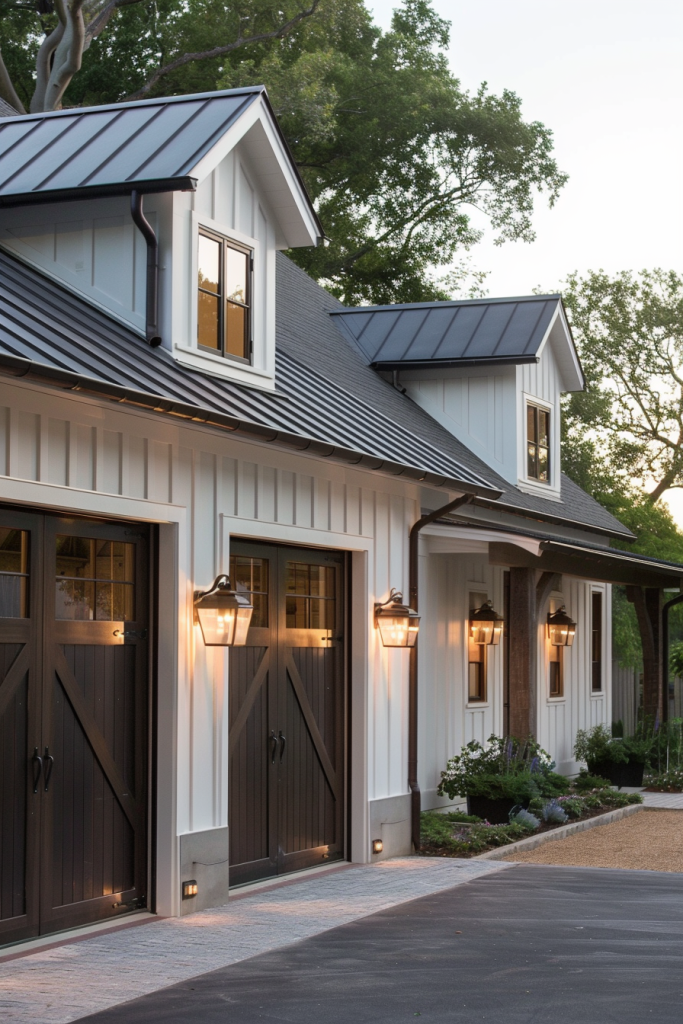
Lighting Strategies
Lighting is a critical component of Modern Farmhouse decor, as it not only illuminates the space but also plays a key role in defining the style and atmosphere. A well-thought-out lighting plan in Modern Farmhouse interiors blends functional lighting with decorative elements, enhancing both the usability and aesthetic appeal of the home. Here’s how effective lighting strategies are implemented in Modern Farmhouse design:
Layered Lighting
One of the fundamental strategies in Modern Farmhouse lighting is the use of layered lighting. This approach involves combining multiple light sources at different levels to create a versatile and inviting atmosphere. The three main types of lighting used are:
- Ambient Lighting: This is the general lighting of the room, usually provided by ceiling fixtures, recessed lighting, or large chandeliers made from rustic materials such as wrought iron or distressed wood. Ambient lighting in Modern Farmhouse decor is often soft and diffused to create a warm and welcoming baseline illumination.
- Task Lighting: As the name suggests, task lighting is focused on areas where specific tasks are performed, such as under-cabinet lighting in the kitchen for food preparation, or table lamps in the living room for reading. These fixtures are functional but also contribute to the overall style, often featuring industrial or vintage designs that complement the farmhouse aesthetic.
- Accent Lighting: This type of lighting is used to highlight architectural features, artwork, or key decor elements, such as painting with directed spotlights or using picture lights. Accent lighting adds depth and dimension to the space, enhancing the visual interest of the decor.
Natural Light
Maximizing natural light is another key aspect of lighting in Modern Farmhouse design. Large windows, often unadorned or with minimal treatments, are a staple of this style. They not only help to brighten the space during the day but also connect the indoors with the natural surroundings, reinforcing the farmhouse ethos of simplicity and a connection to the outdoors.
Statement Lighting Fixtures
In Modern Farmhouse decor, lighting fixtures often serve as focal points in the room. Statement pieces like large, rustic chandeliers or pendant lights made of reclaimed materials can define the aesthetic of the space. These fixtures are typically chosen for their ability to merge functionality with farmhouse charm, featuring elements like exposed bulbs, metalwork, and wood accents.
Outdoor Lighting
The lighting strategy extends beyond the interior spaces to include outdoor areas. Modern Farmhouse exteriors are often equipped with barn-style sconces, lanterns, and pathway lights that enhance the home’s curb appeal and provide necessary illumination for evening activities. These fixtures typically mirror the rustic and vintage styles of the interior lighting, creating a cohesive look throughout the property.
Dimmers and Smart Lighting Controls
Integrating modern technology through dimmers and smart lighting controls allows for flexibility in adjusting the lighting according to different needs and times of day. This adaptability is essential in Modern Farmhouse decor, where the mood and functionality of rooms can change based on the activity or the amount of natural daylight available.
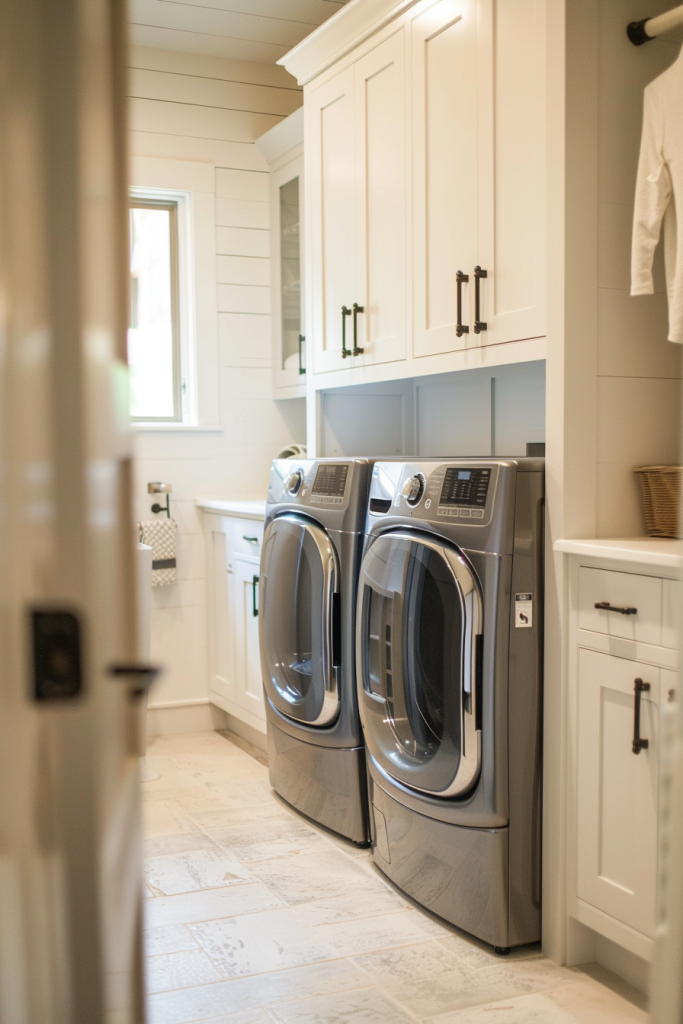
Technology Integrations
Integrating modern technology into Modern Farmhouse decor is essential for maintaining the functionality and comfort of contemporary living while preserving the aesthetic charm of the style. Successful technology integration involves seamlessly blending cutting-edge devices and systems into the rustic and traditional elements that define Modern Farmhouse design. Here’s a closer look at how technology can be thoughtfully incorporated:
Smart Home Devices
Smart home technology is increasingly popular and can enhance the convenience and efficiency of Modern Farmhouse homes. Devices such as smart thermostats, smart lighting systems, and voice-controlled assistants can be integrated to manage home environments efficiently. For instance, a smart thermostat can maintain a comfortable climate without detracting from the decor, especially when placed inconspicuously or designed to blend with traditional elements.
Hidden Technologies
Preserving the aesthetic integrity of Modern Farmhouse interiors often requires hiding or disguising technological elements. Televisions can be recessed into walls or hidden behind custom cabinetry that matches the farmhouse style. Similarly, speakers and other audio equipment can be integrated into furniture or built into walls and ceilings, maintaining the clean lines and rustic feel of the rooms.
Kitchen Appliances
Modern appliances are essential for functionality but can be styled to fit the farmhouse theme. Manufacturers offer refrigerators, dishwashers, and ovens with facade options like paneling that matches cabinetry or in finishes that evoke a vintage feel, such as brushed bronze or matte black. This allows these essential tools to blend seamlessly into the kitchen’s overall design.
Lighting and Window Treatments
Smart lighting systems allow homeowners to control light levels and color temperatures to match the time of day or desired ambiance, all from a smartphone or voice command. Automated window treatments can also be installed, offering the ability to adjust natural light levels without manual effort. These treatments can be selected in materials and styles that complement the Modern Farmhouse look, such as natural fiber roller shades or linen draperies.
Security Systems
Modern security systems, including smart locks, video doorbells, and surveillance cameras, can be incorporated into Modern Farmhouse designs without compromising the home’s aesthetic. Many of these devices are available in styles and finishes that match the rustic-modern theme, ensuring that they are not only functional but also harmonious with the overall decor.
Energy Management
Incorporating technology for better energy management is another aspect of integrating modernity into a farmhouse setting. Solar panels, energy-efficient HVAC systems, and smart water heaters contribute to a home’s functionality and sustainability. These systems can be designed to minimize visual impact, maintaining the visual flow of traditional farmhouse design while providing modern energy solutions.

Common Misconceptions
Modern Farmhouse decor is a popular style known for its warmth and simplicity, blending rustic charm with contemporary sleekness. However, certain misconceptions about what constitutes Modern Farmhouse design can lead to confusion or misinterpretation of the style. Here’s a detailed exploration of common misconceptions and the realities behind them:
“It’s All About Rustic Elements”
Many people believe that Modern Farmhouse decor must include a heavy presence of rustic elements such as distressed wood, vintage furniture, and antique decor. While these elements are characteristic of the style, Modern Farmhouse is equally about balance and subtlety. The modern aspect incorporates clean lines, sleek finishes, and contemporary fixtures. The style is not about recreating a purely rustic look but rather integrating old and new elements in harmony.
“Color Palette Must Be White or Grey Only”
While neutral tones like white and grey are predominant in Modern Farmhouse interiors, they are not the only color options. Accents in darker shades such as navy, forest green, or even black are commonly used to add depth and focus. Additionally, incorporating soft pastels or earthy tones can also complement the Modern Farmhouse aesthetic, providing a broader range of design possibilities without sacrificing the style’s characteristic brightness and openness.
“Only Suitable for Rural Settings”
Another common misconception is that Modern Farmhouse design is only appropriate for homes in rural or country settings. However, the principles of Modern Farmhouse decor—such as simplicity, functionality, and a blend of old and new—can be applied in any setting, including urban and suburban homes. The style’s versatility makes it adaptable to various environments, allowing it to bring warmth and character to any space, regardless of location.
“Limited to DIY or Handmade Items”
While DIY projects and handmade items can certainly enhance the authenticity and personal touch of a Modern Farmhouse interior, they are not requirements for achieving the style. Modern Farmhouse decor can also include professionally crafted pieces, high-end materials, and sleek, modern technology. The key is to maintain a balance that reflects both rustic artisanal charm and contemporary elegance.
“Excessively Ornamental”
Some might confuse Modern Farmhouse with more traditional country styles that often include floral patterns, ruffles, and an abundance of decor items. In contrast, Modern Farmhouse leans towards a more minimalist approach, emphasizing functionality and clean aesthetics. Decor is chosen with purpose and restraint, focusing on quality over quantity and avoiding excessive ornamentation.
“Impractical for Modern Living”
There’s a notion that Modern Farmhouse design isn’t suited to the demands of modern living, perhaps due to its emphasis on vintage elements. However, the style is highly practical, incorporating elements such as open layouts, ample storage, and easy-to-maintain materials. It supports a comfortable and convenient lifestyle while providing a visually appealing and relaxing atmosphere.
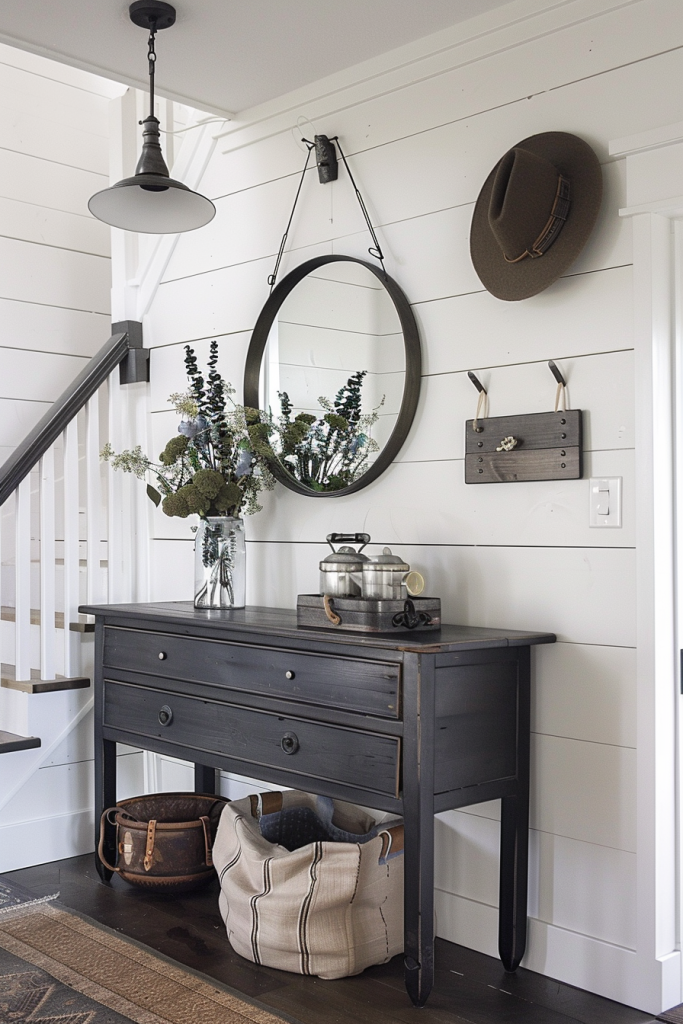
How to Implement Modern Farmhouse in Different Spaces
Implementing Modern Farmhouse decor across various spaces in a home involves understanding the core elements of the style and adapting them to fit the functionality and aesthetic of each individual area. Here’s how you can infuse Modern Farmhouse charm into different rooms, ensuring both style cohesion and practical livability:
Living Room
The living room in a Modern Farmhouse setting should evoke a sense of warmth and welcome. Use plush, comfortable seating arrangements that encourage gathering and conversation. Opt for natural fabrics like linen or cotton in neutral tones, and incorporate throw pillows and blankets for added texture and comfort. Wooden coffee tables with a distressed finish, metal accents in the form of light fixtures or curtain rods, and decorative elements like vintage signs or farmhouse-inspired art pieces can enhance the rustic feel. Area rugs in natural fibers help define the space and add warmth to hardwood floors.
Kitchen
A Modern Farmhouse kitchen is the heart of the home, combining rustic charm with modern functionality. Install shaker-style cabinets painted in soft neutrals or left in natural wood tones. A classic farmhouse sink, possibly in apron-front style, is a signature element, as are butcher block or quartz countertops. Open shelving can display vintage or rustic dishware and glass jars filled with pantry staples. Incorporate a large kitchen island that serves multiple purposes—from prep space to casual dining area. Pendant lights with industrial or antique designs can add character above the island.
Dining Room
The dining room should continue the blend of rustic and modern elements. A large wooden dining table, perhaps with a weathered look or made from reclaimed wood, serves as the centerpiece. Surround it with a mix of seating options, such as bench seating on one side and chairs on the other, possibly in mismatched styles to add eclectic charm. A statement lighting fixture, like a wrought iron chandelier or a series of pendant lights, can hang above the table, providing both light and a focal point.
Bedroom
In the bedroom, comfort is key. Choose a large, inviting bed with a substantial headboard, ideally in a natural wood finish or upholstered in a neutral fabric. Layer bedding in soft, natural materials and muted colors to create a serene and inviting sleeping environment. Include antique or vintage-inspired nightstands and a chest of drawers for practical storage. Soft lighting is important; opt for table lamps with ceramic or metal bases on the nightstands and install dimmable ceiling lights for adjustable ambiance.
Bathroom
Modern Farmhouse bathrooms balance functionality with style. Consider a vanity made from reclaimed wood with a stone countertop for durability and visual appeal. Classic white subway tiles can make up the backsplash, complemented by a walk-in shower with a frameless glass enclosure. Vintage or industrial-style fixtures, like a rainfall showerhead or retro faucets, enhance the old-world charm. Soft, fluffy towels and a jute or sisal rug can complete the look while adding comfort and warmth.
Outdoor Spaces
The Modern Farmhouse style also extends to outdoor living areas. For porches or patios, use outdoor furniture with a rustic flair, such as wicker, teak, or metal in traditional shapes. Include ample cushions and throws for comfort, and consider an outdoor rug to define the seating area. String lights, lanterns, and candles can create a welcoming ambiance for evening gatherings.
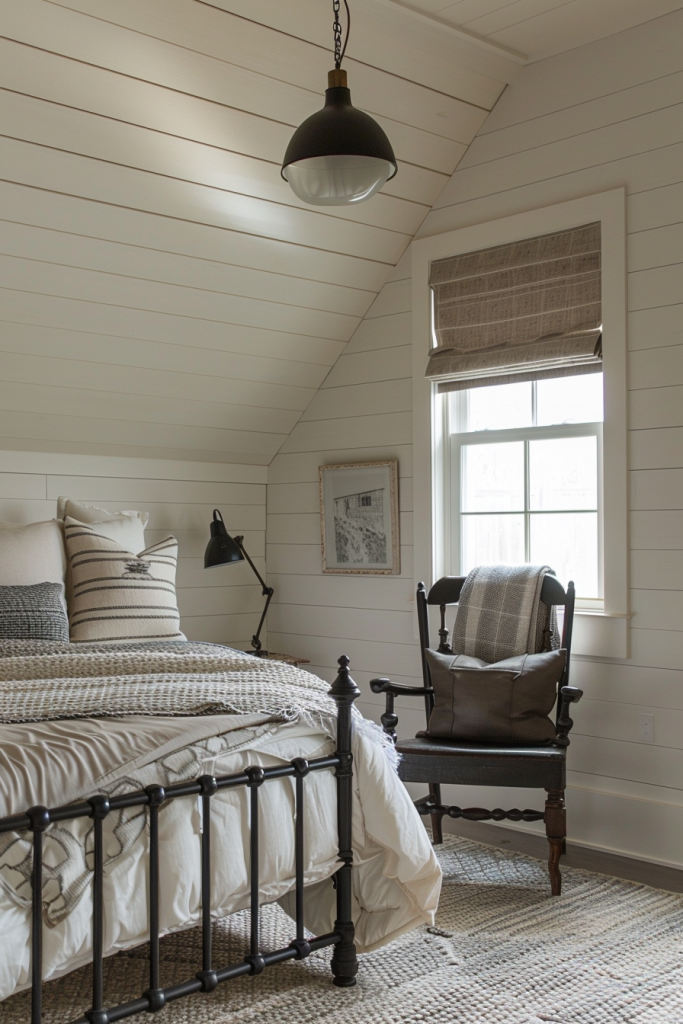
Maintenance Schedule
Maintaining the aesthetic and structural integrity of Modern Farmhouse decor involves a thoughtful approach to the care of materials and finishes commonly used in this style. Here’s a detailed maintenance schedule to ensure your Modern Farmhouse spaces remain beautiful and functional over time:
Wood Surfaces (Floors, Furniture, Beams)
- Daily/Weekly: Sweep or vacuum wood floors regularly to remove dirt and grit that can scratch the surface. Dust wooden furniture and beams with a soft, dry cloth to prevent buildup.
- Monthly: Clean wood surfaces with a wood cleaner or a mild soap and water solution, using a damp cloth. Avoid over-wetting the wood to prevent warping.
- Annually: Inspect wooden elements for signs of wear or damage. Apply a fresh coat of sealant or wood oil to floors and exposed beams to enhance their durability and appearance. For furniture, consider re-waxing or re-polishing to restore shine and protect the surface.
Metal Fixtures (Lighting, Hardware, Decorative Accents)
- Monthly: Dust metal fixtures regularly to prevent dirt accumulation. Use a soft, dry cloth or a feather duster.
- Quarterly: Clean with a suitable metal cleaner or a mild soap solution to remove tarnish or fingerprints, particularly on frequently touched surfaces like door handles and light switches.
- As Needed: Check for signs of rust or corrosion, especially in humid environments or outdoor settings. Apply a protective clear coat or replace fixtures if significant deterioration is evident.
Upholstery (Sofas, Chairs, Curtains)
- Weekly: Vacuum upholstery using an attachment to remove dust and allergens. For curtains, shaking them out or gently vacuuming can keep them fresh.
- Bi-annually: Deep clean upholstery fabrics according to the manufacturer’s instructions. This may involve professional cleaning or specific spot treatment methods for stains.
- Annually: Rotate and flip cushions where possible to ensure even wear. Tighten any loose buttons or seams to prevent further damage.
Natural Stone (Countertops, Flooring, Accents)
- Daily/Weekly: Wipe down stone surfaces with a soft cloth and a mild detergent or stone cleaner to prevent staining.
- Monthly: Use a stone polish to enhance the shine on countertops and decorative stone elements.
- Annually: Seal stone surfaces to protect them from stains and moisture penetration, especially in high-use areas like kitchens and bathrooms.
Textiles (Rugs, Throws, Pillows)
- Weekly: Shake out or vacuum rugs and textiles to remove dust and prevent dirt from settling into the fibers.
- Annually: Deep clean rugs and wash throws and pillow covers, following care labels to ensure proper treatment. Consider professional cleaning for high-value or delicate items.
Outdoor Furniture and Decor
- Monthly: Clean outdoor furniture surfaces to remove dirt, pollen, and other outdoor debris. Cover or store indoors during harsh weather if possible.
- Annually: Check for weather-related damage, such as rust on metal furniture or mildew on wood. Apply water-repellent finishes to wood furniture and anti-rust treatments to metal items.

Challenges and Solutions
Implementing Modern Farmhouse decor, while rewarding, can present several challenges. Understanding these potential obstacles and knowing how to address them can help ensure a smooth transition to this beloved style in your home. Here are some common challenges along with effective solutions:
Balancing Rustic and Modern Elements
- Challenge: One of the trickiest aspects of Modern Farmhouse decor is achieving the right balance between rustic charm and contemporary sleekness. Overemphasizing one can detract from the harmonious blend that defines the style.
- Solution: Focus on mixing materials and finishes. Combine rustic elements like reclaimed wood or vintage pieces with modern materials such as glass and metal. Use contemporary color schemes and clean lines to complement traditional architectural features. Careful selection and placement can create a cohesive look that encapsulates both old and new.
Sourcing Authentic Materials
- Challenge: Finding genuine rustic materials and furnishings that don’t look contrived or kitschy can be difficult, especially in areas where farmhouse-style items are less common.
- Solution: Explore local flea markets, antique shops, and online marketplaces that specialize in vintage goods. For new items with a rustic flair, look for craftsmen or retailers who use traditional techniques or materials. Custom pieces can also be a worthwhile investment to ensure authenticity in your decor.
Keeping the Decor Functional and Practical
- Challenge: Modern Farmhouse decor needs to not only look good but also be functional, especially in active, family-oriented homes. Keeping the space practical while maintaining aesthetic integrity can be challenging.
- Solution: Opt for durable materials and finishes that can withstand daily use. Incorporate plenty of storage solutions to keep the space uncluttered. Use furniture and decor that serve multiple purposes, such as ottomans with storage or benches that can be used for seating or as side tables.
Integrating Technology Without Disrupting the Aesthetic
- Challenge: Modern technology is essential for functionality but can clash with the rustic aesthetic of Modern Farmhouse decor.
- Solution: Choose technology that blends with the interior design. Many modern appliances and gadgets come in designs that mimic traditional styles or can be integrated into furniture or hidden away. For example, refrigerators and dishwashers can be fitted with cabinet fronts that match the surrounding kitchen cabinetry.
Adapting to Different Spaces and Architectural Styles
- Challenge: Not every home’s architecture lends itself easily to the Modern Farmhouse style, which can make the adoption of this decor theme challenging in contemporary or non-traditional spaces.
- Solution: Focus on interior elements that can adapt to any space, such as color schemes, soft furnishings, and decorative items. Use standalone pieces like farmhouse-style tables, barn-style doors, or antique-looking light fixtures to evoke the style without major renovations.
Maintaining a Timeless Look Amidst Trends
- Challenge: Keeping the Modern Farmhouse look timeless and avoiding trends that quickly become dated is crucial for long-term satisfaction with the decor.
- Solution: Stick to classic elements of the style and avoid overly trendy colors or motifs. Invest in high-quality materials and pieces that can stand the test of time both in terms of durability and style. Regular updates with small, easily changed accessories can keep the look fresh without a complete overhaul.
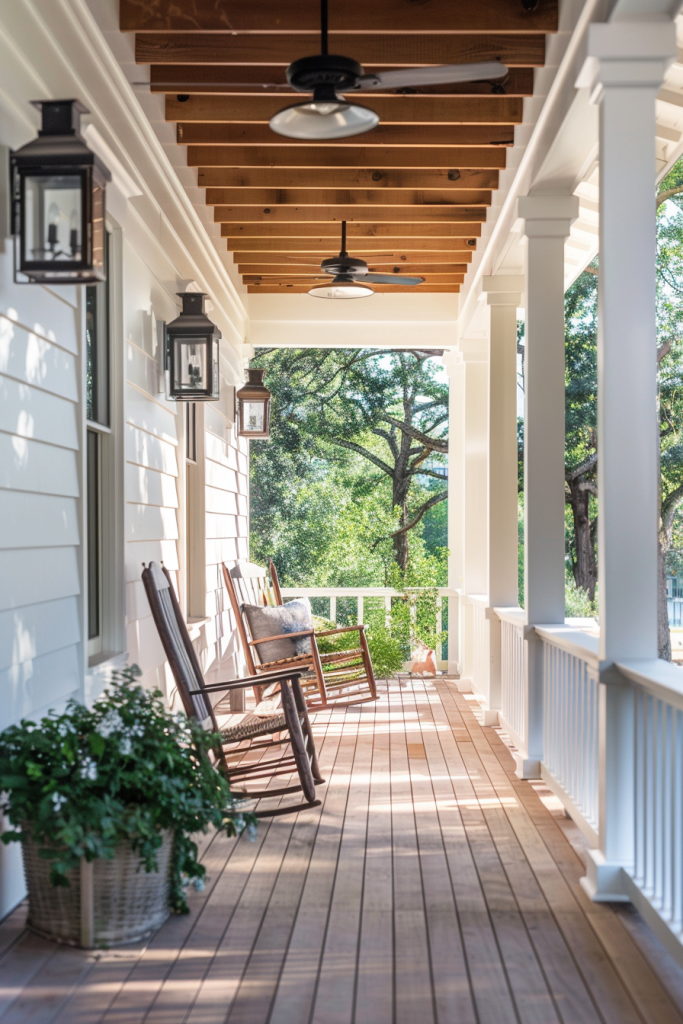
Impact on Mood and Atmosphere
Modern Farmhouse decor significantly influences the mood and atmosphere of a home, fostering an environment that is both welcoming and comfortable. The design elements characteristic of this style — from color and material choices to layout and lighting — are specifically geared towards creating a space that feels relaxed, open, and inviting. Here’s a deeper look at how Modern Farmhouse decor impacts the mood and atmosphere:
Warmth and Comfort
- Influence: The use of natural materials such as wood and stone, combined with a neutral color palette and soft textiles, contributes to a sense of warmth and comfort. These elements are tactile and visually appealing, making spaces feel grounded and nurturing.
- Impact: This creates an atmosphere where occupants feel relaxed and at ease, encouraging gatherings and family time. The warmth makes the home feel like a safe haven from the outside world, enhancing feelings of security and belonging.
Openness and Light
- Influence: Modern Farmhouse design often features open floor plans and large windows that allow for plenty of natural light. The spaces are designed to be airy and bright, with few barriers to light and movement.
- Impact: This openness helps to reduce feelings of confinement and stimulates a positive, energetic mood. Natural light has been shown to boost mood and productivity, making the interior feel more alive and vibrant.
Connection with Nature
- Influence: The style’s emphasis on incorporating elements from the outdoors, such as plants, floral arrangements, and natural textures, helps to forge a connection with nature.
- Impact: This connection is known to have calming effects, reducing stress and enhancing overall well-being. It can make the indoor environment feel more organic and less manufactured, which is soothing and psychologically rewarding.
Simplicity and Clarity
- Influence: The clean lines and uncluttered spaces characteristic of Modern Farmhouse decor contribute to a sense of simplicity and clarity in the home environment.
- Impact: This minimalism helps clear the mind and reduces anxiety, making it easier to relax. It also promotes a sense of order and tranquility, which can be particularly beneficial in today’s often chaotic world.
Sense of History and Continuity
- Influence: The inclusion of vintage or antique pieces within a modern context provides a sense of history and continuity, linking the present with the past.
- Impact: This can evoke a nostalgic comfort, enriching the home’s atmosphere by providing depth and stories that newer items lack. It creates a layered, lived-in feel that many find emotionally enriching.
Casual Elegance
- Influence: While maintaining a relaxed vibe, Modern Farmhouse decor also carries an element of understated elegance. The style avoids ornate details but focuses on beautiful craftsmanship and thoughtful design.
- Impact: This casual elegance ensures that the home feels both stylish and approachable, not overly formal but still refined. It strikes a balance that can satisfy a wide range of tastes, making guests feel welcome and residents proud of their space.

Comparison with Other Decor Styles
Modern Farmhouse decor holds a distinct place in the world of interior design, characterized by its blend of rustic charm and contemporary sleekness. Understanding how it compares to other popular decor styles can help highlight its unique features and appeal. Here’s a detailed comparison of Modern Farmhouse decor with other prominent interior design styles:
Modern Farmhouse vs. Industrial Style
- Similarities: Both styles embrace a utilitarian approach, often featuring open spaces and a mix of raw materials such as metal and wood. Lighting fixtures and furniture often have a functional, minimalist design.
- Differences: Industrial style leans more towards a rugged, urban aesthetic with darker colors, exposed pipes and ducts, and an emphasis on metal and concrete. Modern Farmhouse, in contrast, focuses on a warmer, more homely vibe with softer lines, lighter colors, and a greater emphasis on comfort and coziness.
Modern Farmhouse vs. Scandinavian Style
- Similarities: Scandinavian and Modern Farmhouse styles both prioritize clean lines, neutral colors, and a focus on natural light. They share a love for minimalism and functional design.
- Differences: Scandinavian style is more minimalistic and often incorporates more modern, sometimes even futuristic furniture and finishes. It uses a cooler palette (grays, whites, and blues) and fewer decorative items. Modern Farmhouse incorporates more textures, patterns, and vintage or antique pieces, creating a warmer, more layered look.
Modern Farmhouse vs. Traditional Style
- Similarities: Traditional and Modern Farmhouse styles both incorporate classic elements and place an emphasis on comfort and hospitality.
- Differences: Traditional style tends to be more formal and ornate, with richer colors, more detailed woodworking, and heavier furniture. Modern Farmhouse is more relaxed, with a lighter color palette, simpler lines, and a more casual approach to layout and decor.
Modern Farmhouse vs. Contemporary Style
- Similarities: Contemporary and Modern Farmhouse styles can both integrate sleek, modern elements and emphasize clean, uncluttered spaces.
- Differences: Contemporary design focuses on the here and now, with cutting-edge design, asymmetry, and a boldness in using space and color. Modern Farmhouse draws from the past, providing a timeless feel with rustic elements and a more neutral, subdued color scheme.
Modern Farmhouse vs. Bohemian (Boho) Style
- Similarities: Both styles can incorporate eclectic elements and personalized touches that reflect the homeowner’s taste and experiences.
- Differences: Bohemian style is known for its vibrant colors, rich patterns, and a plethora of textures and layers. It often includes global influences and a carefree, unconventional vibe. Modern Farmhouse, while also personalized, maintains a more restrained palette and organized approach, favoring a blend of rustic and contemporary over eclectic and exotic.
Modern Farmhouse vs. Minimalist Style
- Similarities: Minimalism and Modern Farmhouse both appreciate clean spaces and emphasize functionality in their designs.
- Differences: Minimalist design takes simplicity to an extreme, with very few decorative items, a monochromatic color scheme, and extreme austerity in furniture and layout. Modern Farmhouse, while also appreciating simplicity, allows for more warmth and decorative elements, making it feel more homely and less stark.
Gallery

